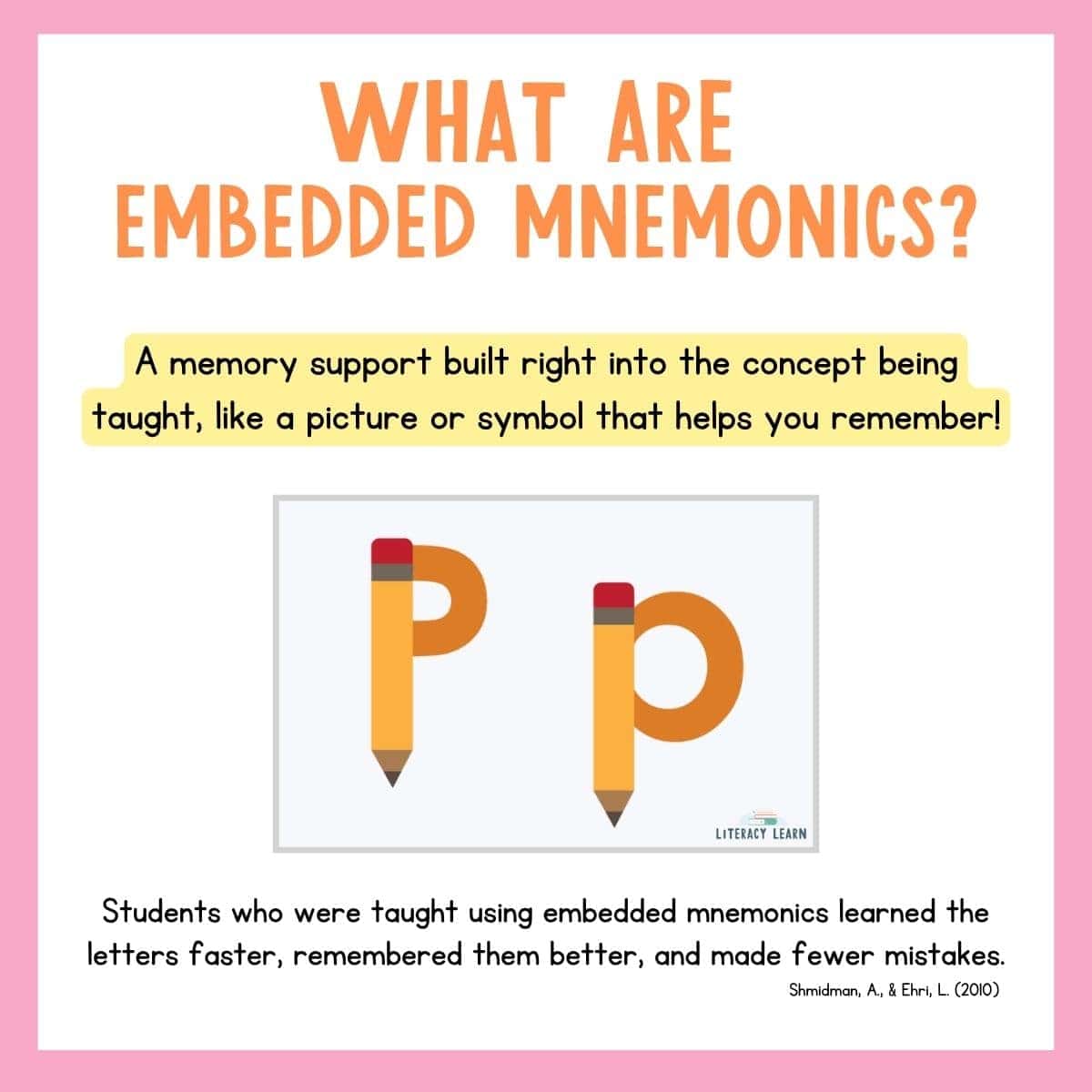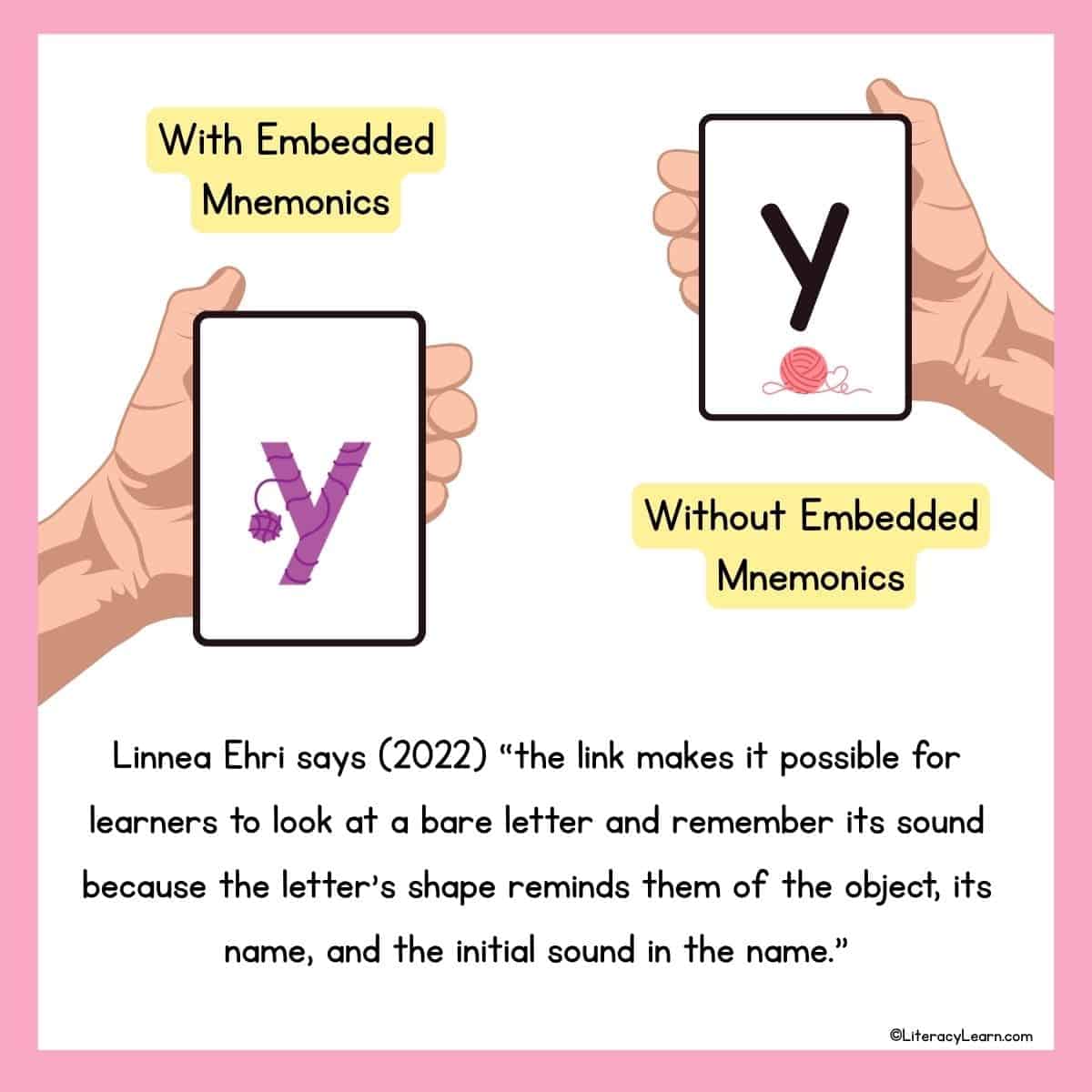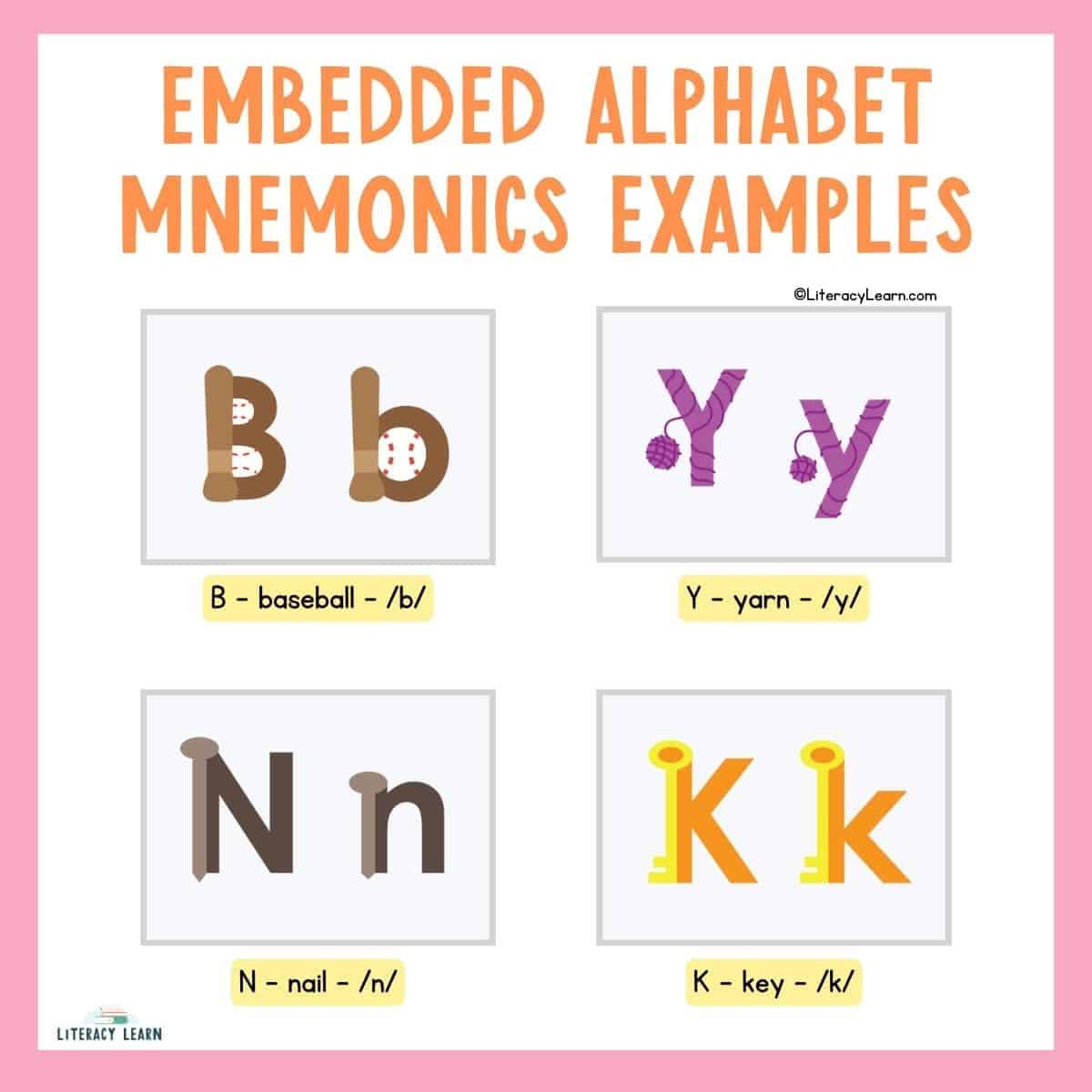Using Embedded Mnemonics to Teach Letters and Sounds
This post may contain affiliate links. As an Amazon affiliate, we earn from qualifying purchases.
Discover why embedded mnemonics are so effective and how they can help students master letters and sounds faster!

What Are Embedded Mnemonics?
Mnemonics is the practice of creating techniques to support and improve memory. These can include things like pictures, acronyms, songs, or chants.
🌈 You might remember the common acronym ROY G. BIV which helped us all remember the colors of a rainbow in the correct order.
🔢 Or maybe you were taught the phrase “Please Excuse My Dear Aunt Sally.” And that helped you remember the correct order of operations.
Embedded Mnemonics takes it one step further. Embedded Mnemonics are a memory support built right into the concept being taught, like a picture or symbol that helps you remember!
These supports are integrated into the instructional materials.
As it relates to the alphabet, the embedded mnemonic is a picture that is associated with a letter and sound.
✏ For example, including a picture of a pencil as the tall stick that starts the letter P is an example of embedded mnemonics in phonics instruction.
To be clear, embedded mnemonics would not be the letter P with a picture of a pencil beneath it. Instead, the pencil is embedded within the letter itself, helping students connect the letter P with its sound /p/ so they can remember and recall it more easily.

Why Use Embedded Alphabet Mnemonics? What the Research Says
When teaching kids the alphabet, research has found that using embedded mnemonics is an effective strategy.
A very interesting study was done by Linnea Ehri and Adina Shmdman in 2009 to test this strategy. They taught English speaking preschool students 10 Hebrew letter-sound relationships (they didn’t teach them English letters/sounds to avoid any previous knowledge or familiarity.) They taught one group using embedded mnemonics and one without.
When the letter shapes were embedded into meaningful pictures, the preschoolers learned the letters faster, remembered them better, and made fewer mistakes. These pictures certainly helped to make the letters and sounds “stick” and supported students in stronger reading and writing foundations.
Linnea Ehri says (2022) “the link makes it possible for learners to look at a bare letter and remember its sound because the letter’s shape reminds them of the object, its name, and the initial sound in the name.”
Another study conducted by Fulk et. al (1998) taught consonant sounds using embedded mnemonics to students with learning disabilities. The study showed that all students significantly improved their letter-sound correspondence knowledge once embedded mnemonics were implemented.
“…It has been found that such embedded mnemonic pictures can reduce the amount of repetition needed for kids to learn the letters and sounds, with less confusion, better long-term memory, and greater ability to transfer or apply this knowledge in reading and spelling.” – Timothy Shanahan
Overall, research supports using embedded mnemonics as a scaffold to build proficiency in their letter-sound knowledge.
When to Use Alphabet Mnemonics
Let’s talk about the different kinds of situations and students who will benefit from using embedded mnemonics.

We want to use embedded mnemonics at the very begininng of letter-sound instruction, typically in pre-k and kindergarten. For some students, this foundational learning continues into first grade as they build automaticity.
Alphabet mnemonics are also effective for older students who still struggle with letter-sound connections. I’ve even used the short vowel mnemonic letters with some middle school students who were still working to master the tricky short vowel sounds. I can attest that they really do work!
If you’re in a prek or kindergarten classroom, embedded mnemonics should be a part of your instruction. First grade teachers can continue to use them, especially at the beginning of the year, as kids transition from kindergarten and build independence.
But if you’re unsure whether your students need them, assess to find out which letter-sound correspondences they already know. Students who can quickly name the letter and produce its sound likely don’t need the extra support of embedded mnemonics. But for those who are still inconsistent or hesitant, embedded mnemonics can be a powerful scaffold to strengthen connections and build automaticity!
Remember, embedded mnemonics are meant to be a temporary support—a scaffold! Think of them like training wheels on a bike. Training wheels help children with balance and confidence at first, but once they’ve mastered the skill, it’s time to take them off and let them ride independently!
How Teachers Can Use Embedded Mnemonics
Below we’re listing some practical, teacher-friendly ways to use embedded mnemonics with students.
- Introduce New Letter Sounds Explicitly and Systematically.
- Use embedded mnemonics with whatever scope and sequence you use! They’re supportive of all programs, so use them with whatever instructional routines you’re already doing.
- One small tweak I’ve made to my direct instruction is to start with the sound first before ever showing the letter. After spending a lot of time exploring the sound, that’s when I connect it to the letter. This helps build awareness of the alphabetic principle.
- Add them to your sound wall!
- This will help students to also anchor the correct mouth position to the sound and letter.
- Use them in small groups.
- Keep a set of cards at your table to provide extra support to teach and review specific letter-sound correspondences.
- Pair them with handwriting practice.
- Have kids write the letter (using explicit movement pathways) while saying the sound and keyword aloud.
- Adding this component makes the activity multisensory, and stengthens both formation and recall
- Example: kids say “N – nail – /n/” while forming the letter.
- Play Games
- “I Spy” – Say things like “I spy the letter that spells the /n/ sound.”
- “Hide and Seek” – Hide cards around the room and have kids find them. When they bring them to you, have kids say the letter name, keyword, and sound.
- “Find and Flip” – At your small group table, turn several alphabet cards facedown. Call out a sound “Find /n/.” Kids take turns flipping until they find the correct letter.
- “Sound Swat” – Lay several cards on the small group table. Say a sound aloud and students have to swat the letter card with a fly swatter or pointer.
- Use at Stations/Centers.
- Simply adding cards to rings, task boxes, or reusable dry erase folders!
- Send home.
- Get parents on board and send the resources home with kids who need additional review.
Embedded Alphabet Mnemonic Resources
If you’re ready to start using embedded alphabet mnemonics with your students, we have lots of resources ready for you!

🌟Join our Premim UNLIMITED Membership and ALL of these resources are included (plus thousands of other amazing resources)! ⬆️
You’ll get…
- Posters (Full Size)
- Two-Sided Flashcards
- Vowel Tents
- Letter Formation Task Cards
- Word Mapping Folder
- Worksheets
- Digital Google Slides
- Digital Blending Board
- and MORE
Buy on TPT: Get the Embedded Mnemonic Alphabet Bundle from TPT that includes everything you need to help students master letter-sound correspondences faster and more effectively through visual and multisensory learning.
💙 Why We Love It
We designed this product intentionally with Science of Reading principles in mind.
💚 Each letter (A-Z plus common digraphs sh, th, and ch) is represented with an embedded image that helps students anchor the sound to the letter.
💜 We used Tier 1 vocabulary words as our keywords sp students could instantly and easily recognize pictures and build connections.
🧡All of our target sounds are the first sound in the word for beginning sound isolation since this is the easiest of the phonemic awareness skills (with the exception of letter X).
💛 The picture directly supports visualization and builds memory.
We hope you make the transition to using embedded mnemonics for your alphabet instruction.
References:
Shanahan, T. (2021, June 12). A Question I Hate: Should We Use Pictures (Embedded Mnemonics) When Teaching Phonics? Shanahan on Literacy. https://www.shanahanonliteracy.com/blog/a-question-i-hate-should-we-use-pictures-embedded-mnemonics-when-teaching-phonics
Shmidman, A., & Ehri, L. (2010). Embedded Picture Mnemonics to Learn Letters. Scientific Studies of Reading, 14(2), 159–182. https://doi.org/10.1080/10888430903117492
